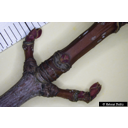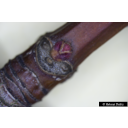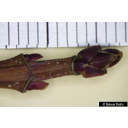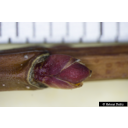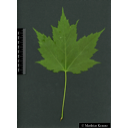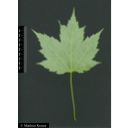Useful information about the taxon (species, subspecies, variety...)
Acer glabrum Torr. 1828
Sapindaceae
(APG IV)Rocky Mountain Maple
Taxon concept: The Plant List (2010)
Distribution: Northern United States; Canada: Rocky Mountains
Size: 6 - 12 (m)
Flowering period: V
Acer glabrum Torr. - Accepted: Acer glabrum Torr. bei Zander 2008; Familie: Aceraceae (Zander 2008)Acer glabrum Torr. - Accepted: Acer glabrum Torr. bei The Plant List (2010); Familie: Sapindaceae (APG III)Acer glabrum Torr. - Accepted: Acer glabrum Torr. bei The Plant List (2014), version 1.1; Familie: Sapindaceae (APG III)Acer glabrum Torr. - Accepted: Acer glabrum Torr. bei The Plant List (2014), version 1.1; Familie: Sapindaceae (APG IV)
- Flowers
- monoecious or dioecious species
- Flower ecology
- wind- and animal-pollinated (anemophilous and zoophilous)
- Life form
- tree or shrub
- Foliage persistence
- deciduous
- Fruits
- winged nut (samara), samara pairs forming an angle under 45°
- Fruit ecology
- wind-dispersed (anemochorous)
- Soil conditions
- on moderately acidic to slightly basic, well-drained, silty, loamy, sandy, and gravelly soils
- Succession type
- seral species in shrub-dominant vegetation, late successional to climax species in floodplain vegetation
- Natural occurrence (habitat)
- coniferous forests, riparian forests and upland deciduous forests; stream banks, alluvial terraces, talus slopes; cool, moist canyons; ridgetops, snow chutes
- Vegetation typ and synecology (plant community)
- temperate to boreal, submesophytic montane mixed coniferous forests
- Constraints according moisture
- weakly to moderately drought tolerant
- Constraints according temperature
- heat tolerant
- Constraints according radiation (light)
- moderately shade tolerant
- Usage
- ornamental tree; used as a timber species for the production of household items and handicraft goods
Haider, M. et al. (2005): Wildbienenkataster. See: https://www.wildbienen-kataster.de; Westrich, P. et al. (2018): Die Wildbienen Deutschlands.. Ulmer Verlag ISBN 978-8186-0123-2.;
Diese Webseite verwendet Google Maps, um Karten und Standorte von Pflanzen in den Hohenheimer Gärten anzuzeigen. Dadurch werden unter Umständen Daten an Google weitergeleitet, was mit einer Verarbeitung Ihrer personenbezogenen Daten verbunden sein kann. Die Datenschutzerklärung von Google finden Sie hier: Datenschutzerklärung von Google
| Sex | Standort | Accession number | Planting year | Donation | IPEN | Lat. | Long. |
|---|---|---|---|---|---|---|---|
| Parzelle E | SP-EB-052-9979 | 2015 | XX-0-HOH-SP-EB-052-9979 | 48,7109143855 | 9,2121278386 | ||
| Parzelle E | SP-EB-014-15747 | 2019 | XX-0-HOH-SP-EB-014-15747 | 48,7112767593 | 9,2117297067 | ||
| male | Parzelle G | SP-GB-025-19 | 2018 | XX-0-HOH-SP-GB-025-19 | 48,7107438448 | 9,213412519 |

